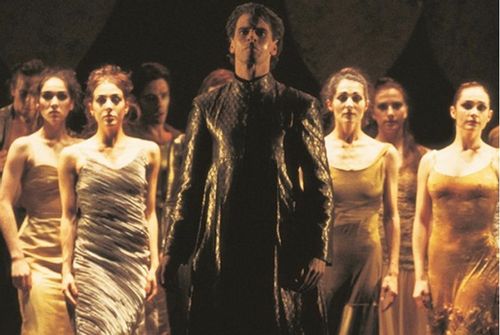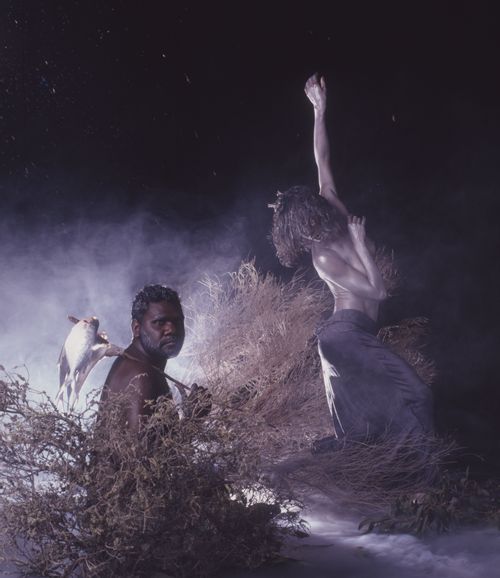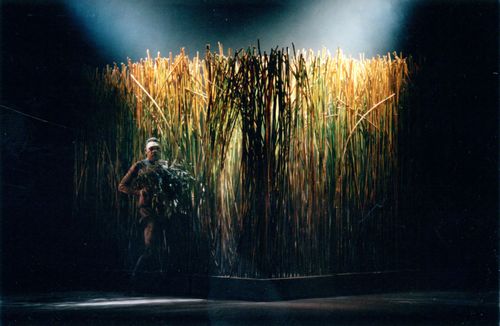Journeys
Steve Francis shares his journey through the 'sound world' of Bangarra
Music Composer Steve Francis takes us on a personal journey, telling how he discovered this 'new' genre of music as David Page ushered him into the Bangarra world.
Music Composer Steve Francis takes us on a personal journey, telling how he discovered this 'new' genre of music as David Page ushered him into the Bangarra world.
"It was an extraordinary, life-changing experience meeting David. And he, for whatever reason, chose me to join him, which was amazing."
Alchemy was when I first met David. He had previously been doing all of the music for Bangarra himself, writing and mixing in his own little studio in Leichhardt. Stephen was doing this show for The Australian Ballet and David was doing the music. Because it was for the Ballet and because it was going to be heard in different venues, David decided he’d better get someone in to help him mix it.
When I was mixing Alchemy, I was startled by how it sounded. I thought it was extraordinary, this blend he had of traditional and contemporary. I mean David created the genre. And people like myself and Paul Mac who work with Bangarra, we just try and find our voice within that genre. David brought Djakapurra into the studio with him one day. Djakapurra went into the booth and sang, this young guy, but it sounded so old and beautiful. I'd never heard anything like it in my life.
To be honest, David probably didn't need anyone to help him, but it was the start of a great collaboration. It was an amazing opportunity for me. I think it was great for David too, I guess, I hope I inspired him a little because he certainly inspired me.
David and I became friends working on Alchemy. Then when he was doing Fish, he asked me to come in and produce the score and mix it. I wasn't writing anything at that stage.
It was an extraordinary, life-changing experience meeting David. And he, for whatever reason, chose me to join him, which was amazing. Until that point, I had nothing to do with contemporary dance or theatre. I was working as a record producer and engineer in Kings Cross, producing soap stars. It was fun, it was great, I enjoyed it, but it didn't feel terribly creative. I’d fallen into a rut.
I moved out of a career in making records to doing dance and theatre. And that's basically what I do now. It's really only through the collaboration with David that I got to become part of this world, and meet this family.
Bangarra is still a family, but it was a much smaller family then. My recollection was that it was just three people in the office. Everyone worked hard. It was slightly low tech, everything felt handmade, but it was amazing. It was incredibly creative. It still is.
When I first met Stephen with Alchemy, he was like “who's this guy?” I think it took him a while to understand the relationship that David and I had created musically. In 2002, David was burnt out and he wanted a year off. Stephen said, “well David wants to take a break, do you want to have a go?”
I love both Fran and Stephen’s approaches but they're very different. Fran was incredibly helpful in giving me direction. She had a very strong idea of what she wanted. With ‘Blankets’, she brought me a track by Nokturnl, which is an Indigenous hard rock band from Alice Springs. I said, “why don't we work with those guys?” So we did.
Stephen's approach is quite different, slightly more abstract. He may just have a single image but that's enough to set you on a path to create something in sync with what he wants. He might have a few small changes, but he's less likely to dig into a piece and rework it.
I was inspired by both of them. I was so excited to be doing it that, in retrospect, I just jumped in and was swept up in the creative process. Maybe that was a little naïve, but I write pretty instinctively. I'm not formally trained. I tend to just go with it.
Shortly after David's passing, Stephen rang me and asked me to come in and do some work. Nyapanyapa is a hard one to talk about because I don’t entirely remember how we did it. We just had to get in there. Obviously, we were grieving. We weren’t in a great state. But the company is bigger than that and it needed to keep going.
Djakapurra’s from Arnhem Land and he knows Nyapanyapa, knows the family. I really wanted to use his voice and I felt like I wanted a song. We sat in the studio next door and we talked a bit about David. I don't think he was prepared to do anything that day, sitting in David's studio, it was hard. But then he started to hum. I said, “wait wait, can I record it?”
Djakapurra sang these two songs and they were so beautiful. They're just amazing. I used them in the show to bookend the piece. And for each of them I wrote string arrangements. It took me a long time because I'm not classically trained. I would just sit there and play with notes until I found what sounded right.
Nyapanyapa was a difficult time for everybody to get a show up. But I felt like I did good somehow.
"David created the genre"
Interview with Steve Frances
Article by Maura Edmond
Steve is a Composer and Sound Designer, originally from Adelaide. An opportunity to produce and mix David Page’s work on Alchemy for The Australian Ballet in 1997 led to an ongoing collaboration with Bangarra.
Explore profile







